Results 11 to 20 of 37
Threaded View
-
08-03-2011, 07:55 PM #1
 WWI Razor? James Barber - Hand Forged
WWI Razor? James Barber - Hand Forged

My latest eBay acquisition.
I've dug around here a fair bit and I can find nothing on a James Barber 'Hand Forged'.
Plus, the stamp on the horn scales strongly resembles the WWI razor refurbs but clearly isn't one of them.
The blade is a hair shy of 6/8ths and is a true wedge. Looks like it's going to be a lovely shaver after some cleanup.
The stamp and blade style make me think 1850s, but I'm just guessing. Anyone have a more informed opinion on this one?-Zak Jarvis. Writer. Artist. Bon vivant.


 9Likes
9Likes LinkBack URL
LinkBack URL About LinkBacks
About LinkBacks







 Reply With Quote
Reply With Quote